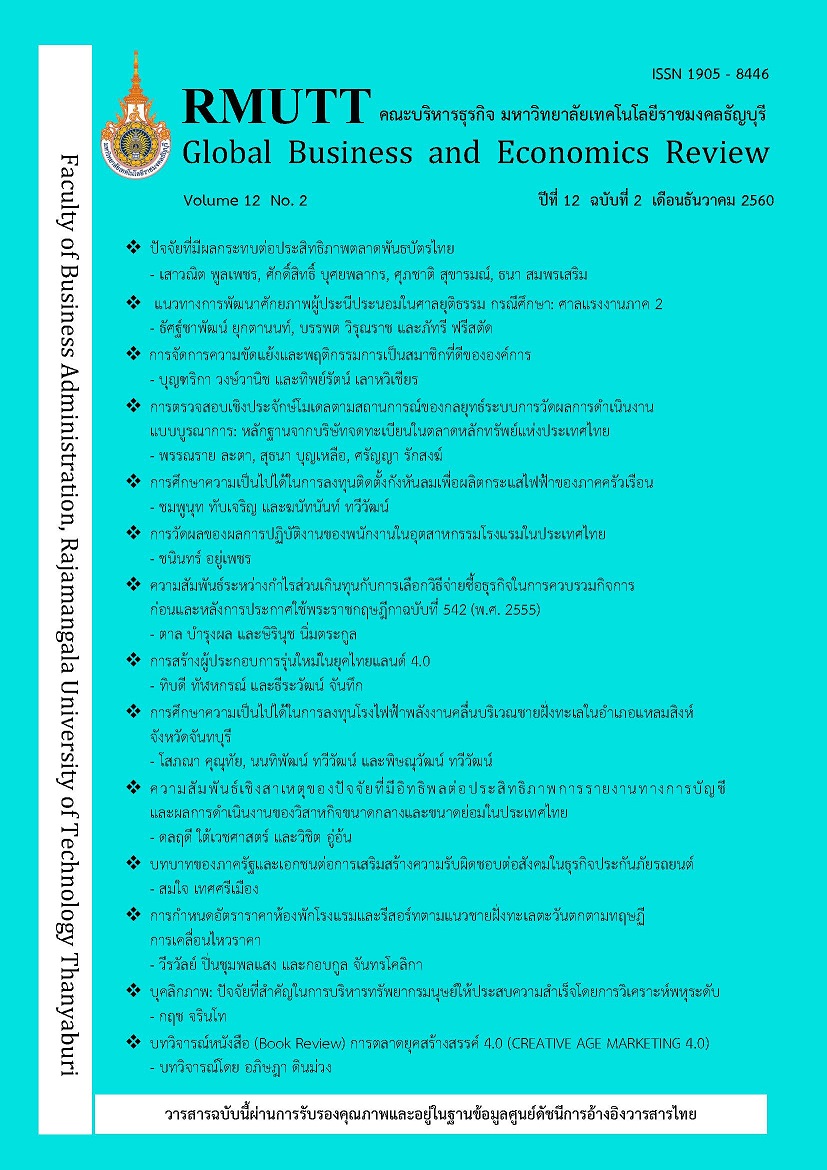ปัจจยัที่มีผลกระทบต่อประสิทธิภาพตลาดพนัธบตัรไทย
คำสำคัญ:
ตลาดพันธบัตรไทย, พันธบัตร, ตลาดพันธบัตรบทคัดย่อ
การพัฒนาตลาดพันธบัตรให้มีประสิทธิภาพเป็นสิ่งสำคัญ เนื่องจากตลาดพันธบัตรเป็นแหล่งระดมทุนทางตรงทั้งภาครัฐและภาคเอกชน รวมถึงเป็นทางเลือกในการลงทุนให้กับนักลงทุน งานวิจัยนี้มีวัตถุประสงค์เพื่อศึกษาปัจจัยที่มีผลกระทบกับประสิทธิภาพตลาดพันธบัตรไทย โดยวิเคราะห์ข้อมูลรายเดือนของพันธบัตรรัฐบาลที่ออกในช่วงเดือน มิถุนายน 2549 – 2558 จำนวน 64 รุ่นผลการศึกษาพบว่า การรายงานข้อมูลการซื้อขายถูกต้องและภายในระยะเวลาที่กำหนด จะทำให้ตลาดพันธบัตรมีประสิทธิภาพด้านข้อมูลข่าวสารและราคาสูงขึ้น ความผันผวนของอัตราผลตอบแทนที่ใช้ในการซื้อขายพันธบัตร อัตราดอกเบี้ย นโยบาย และส่วนต่างระหว่างอัตราผลตอบแทนเสนอซื้อและเสนอขาย ส่งผลกระทบในด้านลบกับ ประสิทธิภาพในด้านการดำเนินงานกับตลาดพันธบัตรไทย ในขณะที่ปริมาณการซื้อพันธบัตรสุทธิของนักลงทุนต่างประเทศ ส่งผลกระทบในด้านบวกกับกับประสิทธิภาพในด้านการดำเนินงานกับตลาดพันธบัตรไทย เมื่อสมาคมตลาดตราสารหนี้ไทยปรับปรุงกระบวนการรายงานข้อมูลการซื้อขายพันธบัตรจะท าให้ตลาดพันธบัตร ไทยมีประสิทธิภาพในด้านข้อมูลและราคาสูงขึ้น เมื่อกระทรวงการคลังกำหนดให้พันธบัตรบางรุ่นเป็นพันธบัตร อ้างอิงในการกำหนดราคาพันธบัตรรุ่นอื่น ๆ และธนาคารแห่งประเทศไทยกำหนดให้สถาบันการเงินและนิติ บุคคลอื่น ๆ ทำธุรกรรมยืมและให้ยืมหลักทรัพย์ได้ จะทำให้ตลาดพันธบัตรไทยมีประสิทธิภาพการดำเนินงานมากขึ้น ดังนั้นหน่วยงานที่เกี่ยวข้องกับการพัฒนาตลาดพันธบัตรไทย ควรมีนโยบายหรือออกกฎระเบียบ เพื่อสนับสนุนให้ตลาดพันธบัตรไทยมีประสิทธิภาพมากขึ้น โดยปรับปรุงกฎระเบียบและนโยบายต่าง ๆ ที่เกี่ยวข้องกับการรายงานข้อมูลการซื้อขายให้มีความถูกต้องแม่นยำมากขึ้น และควรลดต้นทุนในการซื้อขายพันธบัตร รวมทั้งลดความผันผวนของอัตราผลตอบแทนที่ใช้ในการซื้อขายในการซื้อขายพันธบัตรและสนับสนุนให้นักลงทุนต่างประเทศหันมาซื้อพันธบัตรไทยมากขึ้น
References
Aquilina, M., Butterworth, D., Suntheim, F., Winkler, C., & Ysusi, C. (2015, January, 15). Transparency in the UK bond markets: an overview. Financial Conduct Authority. Retrieved from https://ssrn.com/abstract=2885786
Bessembinder, H., Maxwell, W., & Venkataraman, K. (2006). Market transparency, liquidity externalities, and institutional trading costs in corporate bonds. Journal of Financial Economics, 82(2), 251–288.
Borio, C. (2000). Market liquidity and stress: selected issues and policy implications. Bank for International Settlements Quarterly Review, 12, 38-51.
Committee on the Global Financial System. (1999). Market Liquidity: Research Findings and Selected Policy Implications. Bank for International Settlements.
Diaz, A. & Skinner, F. S S. (2001). Estimating corporate yield curves. The Journal of Fixed Income, 11(2), 95–103.
Dow, J., & Gorton, G. (1997). Stock market efficiency and economic efficiency: is there a connection?. Journal of Finance, 52(3), 1087–1129.
Fama, E. (1970). Efficiency capital market: II. Journal of Finance, 25(2), 383-417.
Green, R., Hollifield, B., & Schurhoff, N. (2004). Financial intermediation and the cost of trading in an opaque market. (working paper). Pittsburgh, PA: Carnegie Mellon University.
Harris, L. (2003). Trading and exchanges microstructure for practitioners. Oxford: Oxford University Press.
Mares, A. (2002, August). Market Liquidity and the Role of Public Policy. Bank for International Settlements, 12.
Megginson, W. L. (1997). Corporate Finance Theory, Readin. MA: Addison-Wesley.
Merton, R. C. (1992). Continuous-time finance. Malden, Mass: Blackwell Publishers.
O’Hara, M. (1995). Market Microstructure Theory. Oxford: Basil Blackwell Publishers.
Pemberton, C. M. S., Stewart, A. L. & Watson P. K. (2005). Improving the effectiveness of the market for bonds in the CARICOM sub-region. Retrived from https://sta.uwi.edu/ salises/pubs/workingpapers/4.pdf
Samuelson, P. (1975). Optimum social security in a life-cycle growth model. International Economic Review, 16(3), 539–544.
Sarr, A. & Lybek, T. (2002, December, 1). Measuring liquidity in financial markets. Retrived from https://www.imf.org/en/Publications/WP/Issues/2016/12/30/MeasuringLiquidity-in-Financial-Markets-16211
Upper, C. (2000, February). How safe was the “Safe Haven”? financial market liquidity during the 1998 turbulences. Germany: Deutsche Bundesbank. Retrived from https://www.bundesbank.de/Redaktion/EN/Downloads/Publications/Discussion_Pap er_1/2000/2000_02_01_dkp_01.pdf?__blob=publicationFile
Woodford, M. D. (2002). Financial Market efficiency and the effectiveness of monetary policy. Economic Policy Review, 8(1), 85–94.
The Thai Bond Market Association. (2004). Retrieved September 20, 2016, from http://www.ibond.thaibma.or.th/main/govbond.html
Downloads
เผยแพร่แล้ว
How to Cite
ฉบับ
บท
License
บทความที่ได้รับการตีพิมพ์เป็นลิขสิทธิ์ของผู้นิพนธ์
ข้อความที่ปรากฏในบทความแต่ละเรื่องในวารสารวิชาการเล่มนี้เป็นความคิดเห็นส่วนตัวของผู้เขียนแต่ละท่านไม่เกี่ยวข้องกับมหาวิทยาลัยเทคโนโลยีราชมงคลธัญบุรี และคณาจารย์ท่านอื่นๆในมหาวิทยาลัยฯ แต่อย่างใด ความรับผิดชอบองค์ประกอบทั้งหมดของบทความแต่ละเรื่องเป็นของผู้เขียนแต่ละท่าน หากมีความผิดพลาดใดๆ ผู้เขียนแต่ละท่านจะรับผิดชอบบทความของตนเองแต่ผู้เดียว







